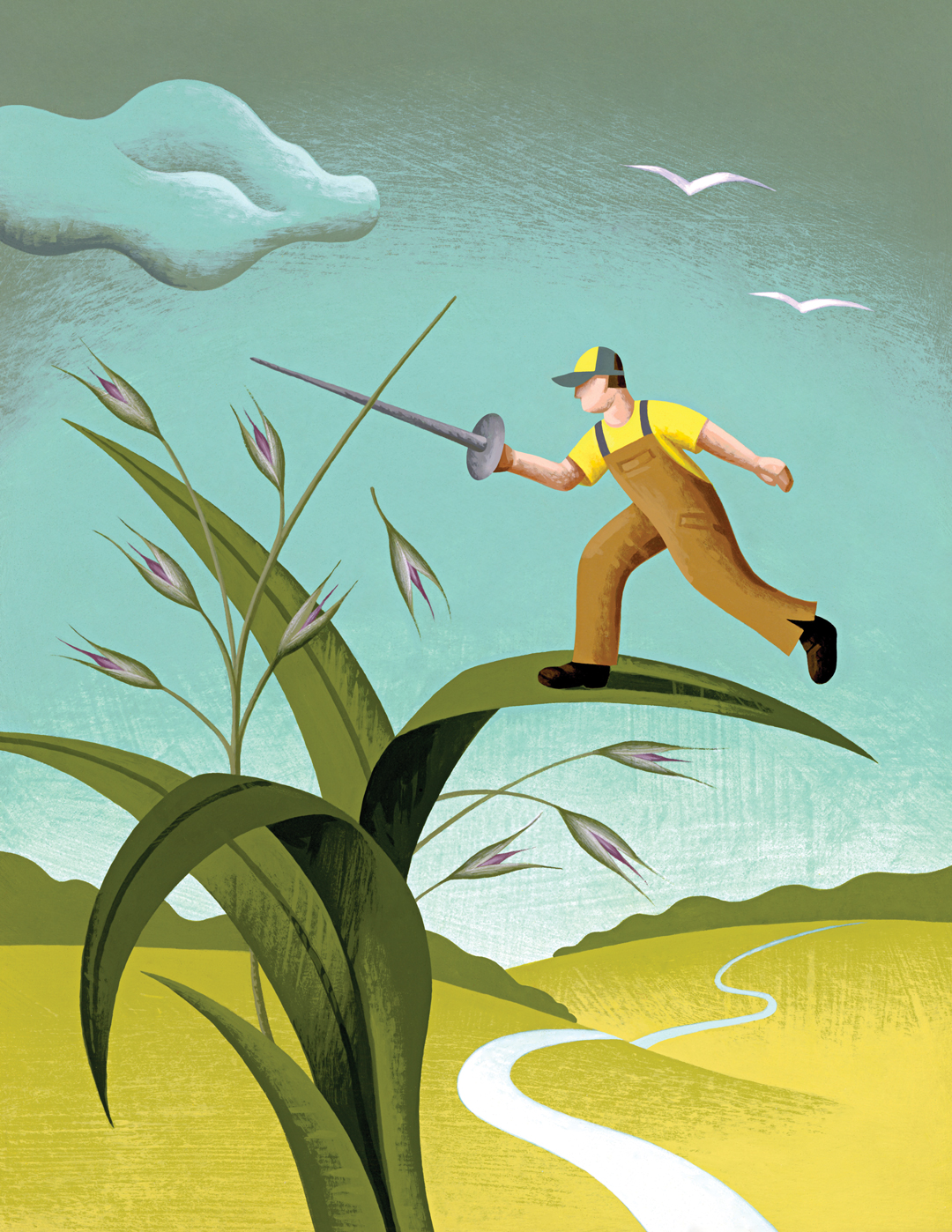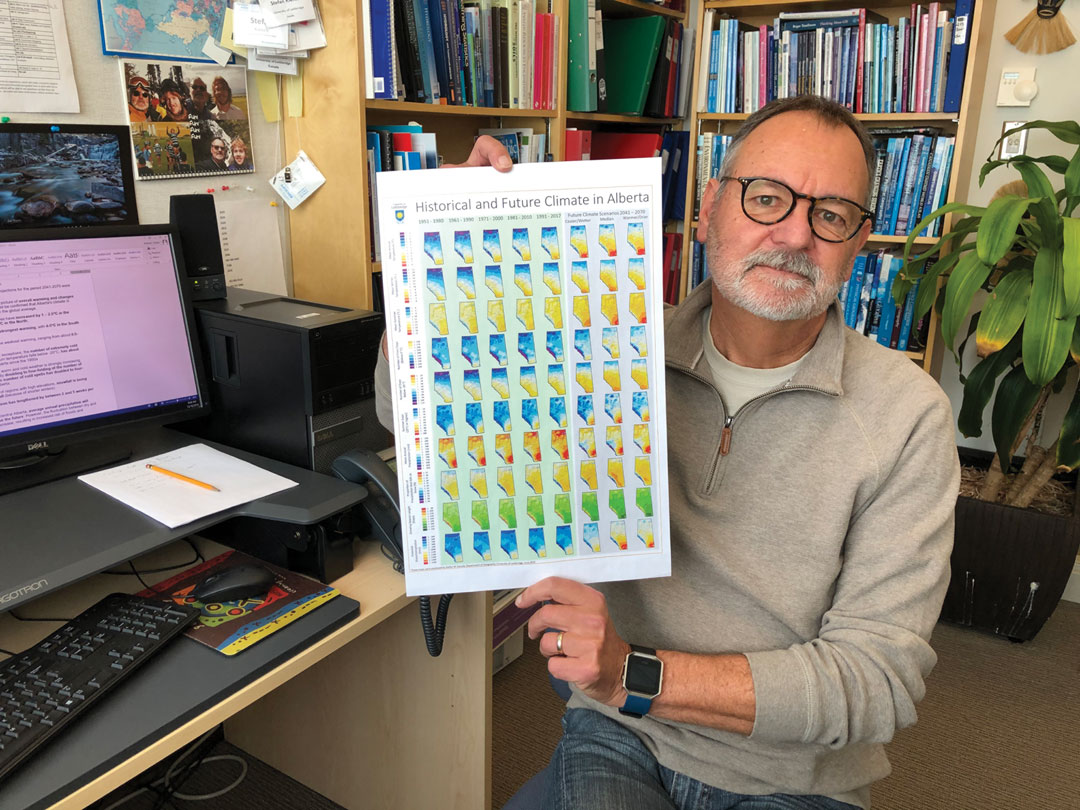CHEMISTRY AND BEYOND
BY MELANIE EPP • ILLUSTRATION BY ADAM NIKLEWICZ
While much research has been conducted on methods to control problem weeds such as kochia and wild oat, most still involves the use of herbicides. “You’re not going to spray your way out of resistance,” said Tom Wolf of Agrimetrix Research & Training. It’s a maxim the professional agrologist uses often.
So where does that leave farmers? Wolf, along with industry experts Charles Geddes, Eric Johnson and Matt Gosling, offer advice for management of herbicide resistance, and where possible, include non-chemical options.
A GROWING PROBLEM
As part of an ongoing survey that began in the early 2000s, Agriculture and Agri-Food Canada (AAFC) research scientist Geddes has surveyed farms across the Prairie provinces for several years to better understand resistance issues. The recently completed Saskatchewan survey found resistance in 74 per cent of the 419 fields tested in 2019 and 2020. A survey will be conducted in Manitoba in 2022 and in Alberta in 2023. According to the last round of surveys led by AAFC’s now-retired Hugh Beckie between 2014 and 2017, herbicide-resistant weeds are found on more than half of Prairie fields.
It’s difficult to determine what herbicide resistance costs the industry. In management questionnaires between 2014 and 2017, Western Canadian farmers estimated its total cost in yield loss or expenses incurred for additional weed control amounted to $13 per acre for a yearly total of $530 million.
While resistance has not grown exponentially, the agronomic practices being employed are not enough to slow its spread. “Roughly, we’re seeing about two new biotypes of herbicide-resistant weeds showing up in Canada each year,” said Geddes. “What that means is we’re continuously seeing selection pressure or new types of resistance showing up. And, of course, these resistant weeds are evading herbicide applications and resulting in crop yield losses among other detrimental effects.”
Group 1-resistant wild oat is by far the most common problem across the Prairies, said Geddes. Much of his work, though, focuses on Canada’s second biggest weed of concern, Group 2-resistant kochia. There is a range of post-emergent herbicides that are effective against kochia, but rapid selection for resistance is taking place. Other glyphosate-resistant weeds are beginning to show up now, too. Southern Alberta, for instance, documented its first case of glyphosate-resistant downy brome last year. As far as anyone knows it’s the only such case in Canada, but Geddes noted full surveys in Manitoba and Alberta have yet to be conducted. “Obviously, that has pretty significant implications when we’re talking about glyphosate being one of the most relied upon herbicides in conservation tillage systems across Western Canada,” said Geddes.
Other surveys also found Group 4 resistance in kochia and triple-resistant kochia biotypes have shown up across the Prairies. This type of resistance drastically limits herbicide options, said Geddes.
In his work, Geddes examines new options for control of herbicide-resistant kochia in spring wheat. He has learned even some of the better control options for Group 2 and Group 9 herbicide-resistant kochia, such as synthetic auxins, may not be sustainable. He did find some Group 14 herbicides effective during burn-off, but some have little residual control. Geddes is concerned higher selection for Group 14 will
occur as glyphosate resistance continues to grow.
As resistance issues mount, Geddes said farmers will want to add non-chemical solutions to their management strategies. The most consistent tool that limits weed seed production is an increased seeding rate, he added. “You need to do whatever you can to promote a competitive crop that can help compete with those weeds.”
Kochia seed production occurs around harvest. Using earlier-maturing crops enables farmers to get in the field sooner, thereby cutting off weed seed production. This allows for additional management tools. Kochia seeds, said Geddes, only remain viable in the soil for one to two years. “If you can prevent seed production for a couple years in a row, that goes a long way to depleting those populations,” he said.

Various weeds require their own unique management strategies. As chair of the Resistant Wild Oat Action Committee, University of Saskatchewan research scientist Eric Johnson has done much work on wild oat biology. He’s found that since wild oat matures earlier, harvest timing tools are less effective. Launched in 2021, the committee is testing strategies to manage the growing problem.
While this work is in its preliminary stages, the committee’s farmer members lead a series of projects to evaluate alternative control methods. Led by Nathan Eshpeter, the farmer group is evaluating tillage practices. These include inversion tillage, to determine if it can bury seeds deep enough to reduce their viability. The committee is also conducting a sampling program, working with fellow farmers who have never before tested wild oat fields for resistance.
Johnson said they hope to evaluate the impact of winter-seeded crops such as fall rye to see if they can outcompete wild oat. In the meantime, he said, they will assess additional tools and techniques. These include increased seeding rates, layered herbicides and fall-seeded and short-term forage crops to promote competition.
“We’ve proven that all of these things work,” said Johnson. “Part of the problem is farmer adoption. In some cases, they are using them, and in other cases things like short-term forages just don’t fit their situations.”
Johnson said the plan is to evaluate interrow spraying and non-chemical solutions, such as the X-Steam-inator. Designed in Saskatchewan, X-Steam-inator is a sprayer that uses electricity to generate high-temperature steam on demand to kill weeds and terminate plant growth. So far, uptake hasn’t been huge.
“We’re still in the infancy stage,” said Johnson. “They have a number of practices they can employ, but growers are looking for a broader suite of practices they can use.”
Independent crop consultant Matt Gosling has worked with central Alberta farmers for 20 years in what he calls a “unique geography” in terms of herbicide-resistant kochia. On the 150,000 acres his consultancy covers, Gosling has found Group 2 and Group 9 resistant, as well as suspected Group 4 resistant kochia biotypes. But he also sees resistance issues in chickweed, which is particularly problematic as it flourishes in higher organic matter soil, even under a competitive crop canopy.
Gosling asks farm clients if they have a plan B for when they find total or majority resistance to Group 1 and 2 herbicides in wild oat. Most don’t have an answer, he said. “My go-to rotation for Group 1, Group 2 wild oat resistance is barley silage, hybrid fall rye, Roundup Ready canola or Liberty, repeat,” he said. “It’s a three-crop rotation that involves silage, so you need a livestock enterprise within a few miles for this to work.” Spring moisture is crucial for this rotation to work, Gosling admits.
Seeding date is also a very underutilized tool, he said. “If you’ve got a field with weeds that are really winning the war, so to speak, I would put seeding dates further back in the calendar, get aggressive with a pre-seed burn-off and wait for conditions that allow a crop to come up as quickly and aggressively as possible, with higher seeding rates.”
In worst case scenarios, Gosling recommends switching to forage. “It’ll typically be really, really ugly until that forage gets established,” he said. “But a lot of these weeds need some sort of tillage to encourage germination, so if we can get a good forage established in there ….”
But not all Prairie farmers have access to forage equipment, which makes this option less feasible. Gosling’s final recommendation is one that is often not well received. Depending on the weed, plowing can be a useful tool to bury weed seed enough that it can’t germinate. “It’ll probably be a last strategy,” he said, adding that plowing is certainly not a strategy for wild oat management as it can germinate from a very deep profile.
His real hope, though, is that sensor technology, including spot sprayers and drones, becomes more readily available and utilized. He doesn’t know of any farmers who now use such methods.
An expert in spray application technology, Wolf’s expertise lies in spray drift, pesticide efficacy and sprayer tank cleanout. As someone who has focused his career on the use of spray technology, he discusses herbicide resistance with mixed feelings. “Resistance to herbicides is caused by the use of herbicides,” he said. “Some of the solutions to herbicide resistance are, in the short-term, herbicides, strangely enough. Which, however, will lead to more resistance,” he added. “It’s not a long-term solution.”
Wolf admitted it’s a conundrum. The only true way to manage herbicide resistance is to not spray. But since this is simply not feasible, especially on large farms, he divides his approach into two lines of thinking. The first is to try to develop methods that prolong the utility of herbicides, but the other is develop a backup option for when herbicides are no longer viable.
“Really, we just need one weed, just one, that doesn’t allow us control with any herbicide,” he said. “Because what do you do with that one weed? It will now thrive regardless of what you do with chemicals.
“That weed doesn’t have a name right now but it could be palmer amaranth,” he added. “If you can’t control palmer amaranth with herbicides, then you have no choice but to go to non-herbicidal methods. And I think we would be wise to plan for that day.”
Like Gosling, Wolf has high hopes for sensor technology in the short-term. Spot sprayers, for instance, would allow for the use of multiple effective modes of action, previously considered too expensive, in a targeted way. Spot sprayers can be powerful agronomic tools beyond spraying, too. Wolf knows a farmer in western Saskatchewan who uses the spray volume map that his sprayer produces to work out the location of problematic weed patches. He then investigates the field to see what else can be done to manage the problem.
Wolf pointed to further developments in the use of spray maps. For instance, he said, Geco Engineering founder and CEO Greg Stewart is categorizing the colour and shape of weed patches in an attempt to predict whether a shape is associated with a particular colour or resistance.
“If you have a shape or a patch that might be long and narrow, it’s perhaps spread by a combine, so the Seed Destructor might be a useful intervening tool,” said Wolf.
An Australian invention, the Harrington Seed Destructor uses a mechanical mill to crush weed seeds as they exit the combine at harvest, which prevents them from returning whole to the soil.
Another option is green-on-brown sprayer, WEEDit from Dutch company Rometron. The sprayer senses plants by measuring reflected light that is associated with photosynthesis. The system works well, can detect small weeds and supports travel speeds of up to 24 km/h, said Wolf. There are about 12 such systems in operation in Western Canada, primarily southern Alberta and Saskatchewan. A second system called WeedSeeker, produced by Trimble, uses normalized difference vegetation index (NDVI) to detect green plants. It has similar features to WEEDit, but lags a bit in resolution, said Wolf.
Green-on-brown systems pay for themselves in the long-term, said Wolf. A simple calculation of $10 per acre for a pre-burn application on 10,000 acres, requires $100,000 in chemicals. Green-on-brown sprayers can lower herbicide use by as much as 70 per cent, which saves a farmer $70,000 in a year. At a cost of approximately, $200,000, the machine can be paid off in just three years. A more conservative estimate would have it paid off in five, said Wolf.
Green-on-green sprayer systems can detect weeds in green crop and selectively spray them as needed. Bilberry’s Greenview sprayer, the current leader in this area, is now commercially available only in Australia.
Additional options now near market-ready include John Deere’s See & Spray Ultimate, Greeneye, Carbon Bee, Exxact Robotics and Precision AI. While these tools are not yet available, it’s important farmers take the time to look forward and plan for the inevitable. “This is a human problem, not a technological problem,” said Wolf. “The recognition of the problem is what is actually the problem.
“I mean, I see the writing on the wall,” he added. “It’s always difficult to predict the future, but if we look at past trends of the development of resistance, it’s going up in a linear way with time. We would be silly to ignore that trend. If our practices don’t change, it will continue to grow.”







Comments